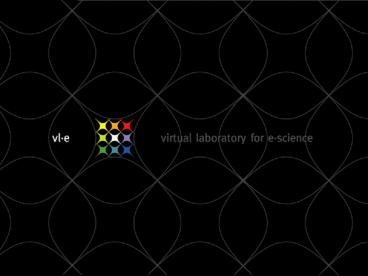Developments and Activities in VL-e Medical - PowerPoint PPT Presentation
Title:
Developments and Activities in VL-e Medical
Description:
Problem-Solving Environment (PSE) for Medical Imaging ... Magneto. Encephalography. System (MEG) courtesy CTF MEG Systems. Analysis tool for MEG data ... – PowerPoint PPT presentation
Number of Views:54
Avg rating:3.0/5.0
Title: Developments and Activities in VL-e Medical
1
(No Transcript)
2
Developments and Activities in VL-e Medical
- Sílvia D. Olabarriaga
- Informatics Institute, UvA
- silvia_at_science.uva.nl
3
Overview
- Introduction
- Activities and Status
- Concluding Remarks
4
Introduction
- Goal of VL-e Medical
- Problem-Solving Environment (PSE) for Medical
Imaging Applications (MIA)
5
Medical Imaging Workflow
MR scanner
PACS
Radiology
Examination/Viewing
6
MIA Some Problems
- Data Storage
- Large capacity, long-term
- Data Analysis
- Computation capacity (latency, throughput)
- Software interoperability
- Data Access
- Remote access (dispersed organizations)
- Controlled access (multiple users)
- Security (patient data privacy)
- Data Logistics and Management
- Heterogeneous and dispersed systems
- Workflow integration and automation
7
VL-e Medical Goals
- Provide shared access to high performance
computation resources - Reduce latency
- Increase throughput
- Large storage capacity
- Facilitate data logistics and management
- Facilitate user collaboration
- Facilitate remote and shared access to data
for advanced clinical and research applications
8
Overview
- Introduction
- Activities and Status
- Concluding Remarks
9
VL-e Medical Activities
- Analysis
- DTI fiber tracking
- MEG data analysis
- SPECT simulation
- DTI-based population studies
- Interactive visualization of brain images
- Workflow
- Integration and automation
- Rapid prototyping (SP2.3)
- Virtual lab for fMRI
10
MEG Functional Imaging
MEG signals
Analysis tool for MEG data courtesy VUMC MEG
Centrum
11
MEG Data Analysis
- Problem
- Locating the sources of brain activation is
computation intensive (fit data to model) - Approach
- Optimized and parallel model fitting algorithm
- IBIS
- DAS-2 cluster
- Status
- More robust model fitting is feasible
12
DTI-basedPopulation Studies
MR scanner
Courtesy of the AMC and TU Delft, Matthan Caan
13
DTI-basedPopulation Studies
- Problem
- New techniques to discriminate populations
- Image analysis is computation-intensive
- Approach
- Use pattern classification techniques
- Use parallel processing for throughput
- Status
- Successful characterization of schizophrenic
patients vs. controls
14
Interactive Visualization of Brain Images
15
Interactive Visualization of Brain Images
- Problem
- Intuitive Interaction with 3D data
- Visualization of 3D data is computation-intensive
- Approach
- Collocated visualization of brain imaging data
- Rendering performed remotely
- Results
- Interactive high-end visualization is possible on
low-end machine
16
Application Development
- Problem
- Rapid prototyping of interactive applications
(analysis, visualization) - Approach
- Visual programming, component-based
- DeVIDE The Delft Visualization and Image
Processing Development Environment - Results
- Successfully used for several applications (e.g.,
planning of shoulder surgery)
17
DeVIDE
Courtesy of the TU Delft, Charl Botha
18
Functional MRI Studies
fMRI scan
Brain activation maps
19
Virtual Lab for fMRI
- Problem
- Population studies multiple centers, multiple
users, many data instances - Approach
- Use VL-e PoC resources SRB, EDG
- Tools to facilitate data acquisition, storage,
analysis, shared access and logistics
20
Virtual Lab for fMRI
21
Overview
- Introduction
- Activities and Status
- Concluding Remarks
22
VL-e Medical Goals x Status
- Provide access to high performance computation
resources - Reduce latency
- Increase throughput
- Large storage capacity
- Facilitate data logistics and management
- Facilitate user collaboration
- Facilitate remote and shared access to data
for advanced clinical and research applications
23
Concluding Remarks
- Application perspective
- Several pilot applications illustrate the benefit
of using grid technology - Benefit for the end user still has to be shown!
- IT perspective
- Limited use of the VL-e PoC so far
- Integration (software, people) is tough..
- fMRI use case has been a positive experience
24
Thanks to
- Jeroen Snel, Aart Nederveen, Matthan Caan,
Charles Majoie, Kees Grimbergen, Ard den Heeten,
Frans Vos, Erik Akkerman - Rob Belleman, Michael Scarpa, Adam Belloum,
Paul van de Hooft, Piter de Boer, Hakan Yakali,
Bob Herzberger - Charl Botha, Jorik Blaas, Frits Post
- Anca Bucur, Henk Obbink, Rene Koostra, Jasper van
Leeuwen, Ronald van Driel, Frank Hoogenraad - Bob van Dijk, Keith Cover
- Maurice Bouwhuis, Bart Heupers
25
(No Transcript)































